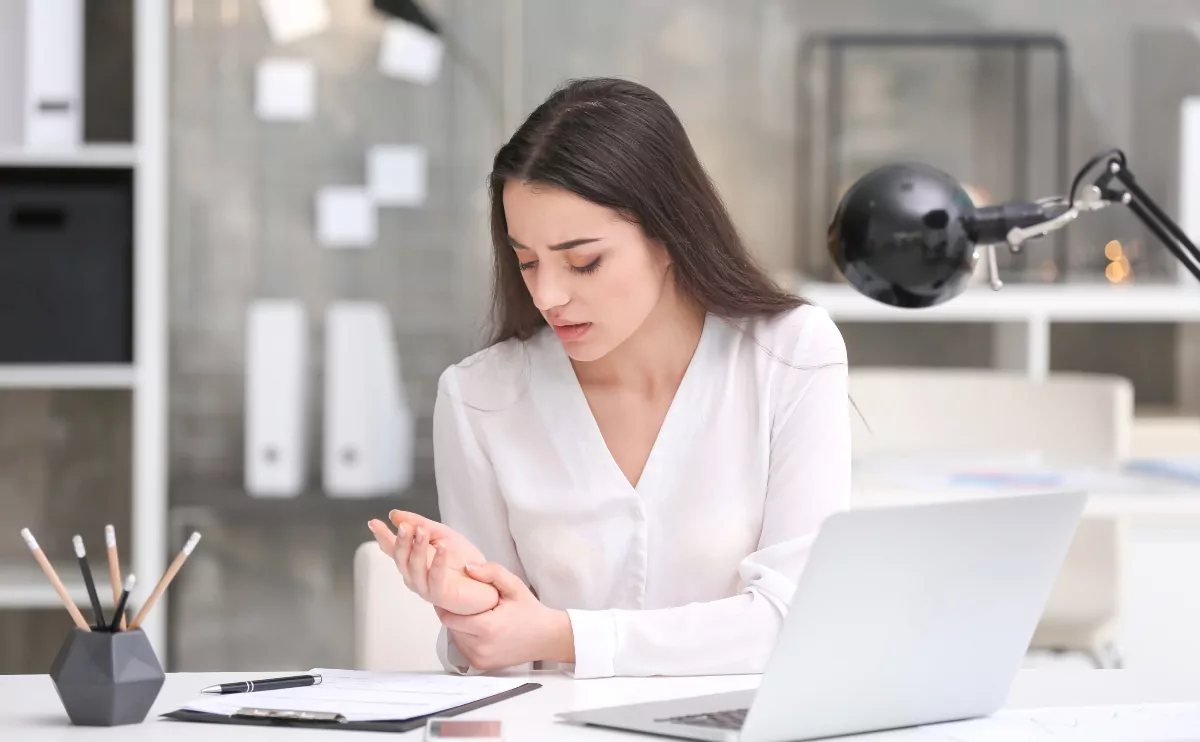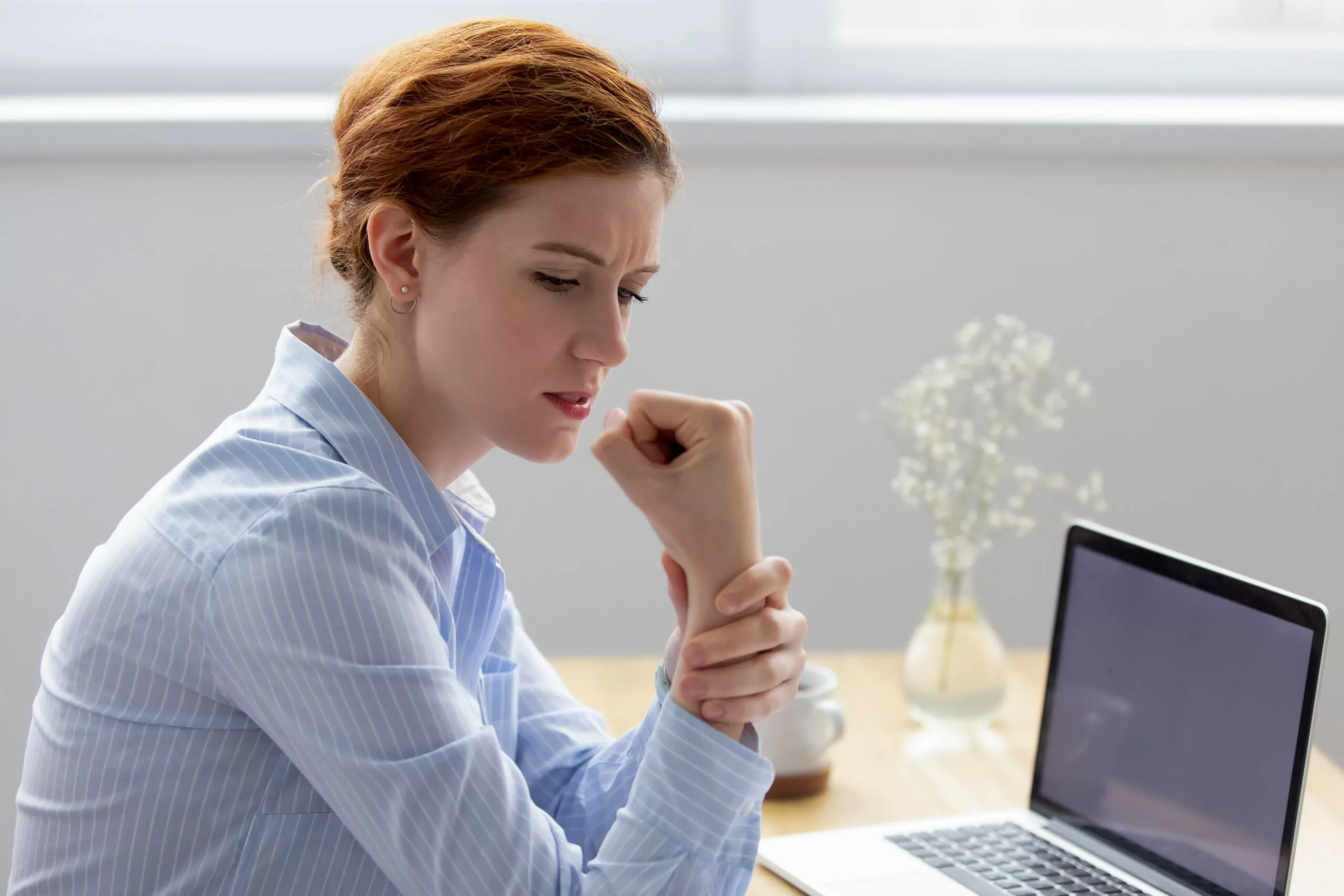Here’s how to avoid wrist pain when using a laptop touchpad:
The best thing you can do is rest your wrists.
Take breaks while using the laptop, and try to find reasons to spend less time using the touchpad in a general sense.
Beyond that, you can try to use your wrist less to control the touchpad (relegating more of the movement to your shoulder), and even get medical help.
So if you want to learn all about managing wrist pain when using a laptop touchpad, then this article is for you.
Keep reading!

Why Do You Get Wrist Pain When Using Laptop Touchpad? (3 Reasons)

If you want to avoid wrist pain, it’s going to help a lot to first understand where the pain comes from.
Don’t worry, we don’t need to get too technical here.
Basically, the pain happens because you’re bending your wrist funny or otherwise putting it in an uncomfortable position.
I’m going to break down more specifics about strain, stress, and injuries that are often associated with laptop use.
Once you understand the source of the pain, the remedies I suggest will make more sense.
#1 Strain
The pain usually comes from two places: your hand position and minor impacts.
Let’s talk about hand position first.
When you use a laptop, you might have it at a nice desk that is ergonomically designed just for you.
Or, you might be sitting on a couch, at a kitchen table, lying in bed, or any number of other arrangements.
In many of these scenarios, you’re bending your wrist at an awkward angle in order to use the trackpad.
It’s not a normal wrist position and posture, and that creates strain.
The longer you use the trackpad, the more your wrist starts to hurt, ache, and even throb.
This is a basic concept of strain.
It’s the same as when you sleep in a funny position and wake up with a sore neck.
When your body is physically strained for a long period of time, it starts to hurt, and this can definitely happen with your wrist when you use a laptop for a while.
#2 Impacts
I told you that the second common cause is from minor impacts.
When you use the trackpad, you often tap on it.
For most people, you’re not pounding away at the trackpad so hard that it knocks your wrist around.
But, if you’re doing a lot of clicking or tapping, the very minor, usually harmless impacts can add up.
Over time, the accumulated impacts start to create stress inside of your hands and arms, and that can lead to wrist pain.
In plenty of cases, the pain is temporary and goes away with rest.
In more severe cases, the impacts (often combined with long-term strain) can cause genuine injuries that require medical treatment.
#3 Stress Injury
These types of injuries are usually called repetitive stress injuries, and you’ve probably heard of two of the most common among them:
These are very different problems that can come from the same source: too much strain and too many small impacts over a long period of time.
In either case, stress injury can cause severe pain.
On top of that, the pain can persist even when you aren’t using your laptop.
They are serious conditions, and you should consult with a medical professional if you think either might be the case.
Left untreated, these issues can lead to a loss of motor function, even worse chronic pain, and permanent injuries that mess with your ability to use your hands and wrists.
They’re typically very treatable, but only if you get out in front of the problem.
How Can You Manage Wrist Pain When Using Laptop Touchpad? (6 Ways)

Ok. We know that the pain primarily comes from stress and impact.
How do you prevent or manage the pain?
Well, it stands to reason that you want to minimize any stress and impact associated with using your laptop.
There are several ways to do this, and I’ll walk you through each of them.
While we’re at it, I’ll also talk to you about medical issues and treatments that might apply to your situation.
The whole point is to be thorough, so keep in mind that no one of these is likely a perfect solution to your wrist pain.
But, when you go through all of them, you’ll have enough knowledge to try to adequately tackle the problem.
#1 Posture and Setup
The easiest way to reduce strain in your rest is to set up a workstation that is designed around your body.
You want a setup that pushes you to use good posture.
You don’t need to balance a book on your head or anything, but if you consistently sit up straight, it will be a lot easier to find consistent postures that don’t strain your wrist.
As for your wrists, you want them to be relatively straight as you work.
Any bend in your arm should be at the elbow instead of the wrists.
If you’re having to pull up shapely on your wrists just to use the computer, then you’re creating a lot of strain, and you’ll feel it later.
Ideally, you can also set up your station so that you can keep your head level to look straight at the computer screen, but with only a laptop and concerns for wrist pain, that’s tricky.
Usually, you would need either an external mouse and keyboard or an external monitor to satisfy that condition.
#2 Technique
Technique also matters a lot.
Even if you have a perfect ergonomic setup, if you don’t make good use of it, you’ll still end up with pain.
When you’re using your laptop, there are a few tips that go a long way.
First, avoid resting your wrists on the tabletop or the edge of the laptop.
You actually want to hold your arms up so that your wrists float above the computer.
When you rest on the wrists, you typically bend them a little and create angulated pressure that adds to your total wrist strain.
Additionally, when you control the touchpad, you don’t want to do that with wrist movement.
Instead, move your shoulder and underarm, much like you would to write on a whiteboard.
By offloading the movements to larger muscle groups, you further reduce strain and the risk of developing any repetitive stress injuries.
#3 Breaks
This might be the most important tip in the bunch.
Take regular breaks.
If you do, your wrists can rest and recover from the strain they experience.
This allows for a bit of a reset, and it will dramatically reduce any pain—especially the accumulation of pain over long periods of time.
If your wrists start to hurt, take a break.
Even if your wrists don’t hurt, schedule breaks.
Take a minimum of a 15-minute break every 2 hours.
If possible, aim for 10 minutes every hour.
That will help break up the monotony and reduce strain and help your wrists feel better all around.
#4 Braces
Some of you have already tried the steps above.
You know that the problem has to do with how you hold your wrists when you use the laptop, but because they already hurt, it’s difficult to fix the problem.
This is where wrist braces can help a lot.
If you can get a good brace, it will hold your wrist at the appropriate posture.
It will force you to control the touchpad with larger muscle movements, and it will minimize strain while you work on your laptop.
There are two things to remember when using a brace.
First, a brace that is worn incorrectly can actually make the problem worse, or even add new problems into the mix.
So, work with a medical professional or physical therapist to find a brace that is appropriate, and learn how to wear it the right way.
Second, a brace is not a silver bullet.
Ultimately, you have pain because you need more rest.
The brace is only there to help you minimize strain when you absolutely have to use the laptop.
Using the laptop less is the ultimate solution.
#5 Physical Therapy
Especially if you have chronic pain, consider working with a physical therapist.
This is an occupation that specializes in work-related injuries and repetitive stress problems.
A physical therapist can analyze the physiological problems at play to deduce the root cause of the pain.
Once identified, the physical therapist can help you combat your pain at the source.
They can teach you stretches and exercises that will specifically bolster your wrist (and hands and arms) against strain and stress.
Over time, you will build up your wrists, and they’ll stop hurting (at least, that’s the theory).
One of the best things about physical therapy is that you can learn it, and then you don’t need constant expert supervision.
In other words, you don’t have to pay for endless physical therapy sessions.
Let them diagnose the problem and teach you what you need to know.
After that, you can take care of yourself, and you’re likely to find a lasting solution to the problem.
#6 Medical Treatments
Unfortunately, even physical therapy isn’t always enough, and that’s especially true with the long-term injuries we’ve already discussed (such as carpal tunnel syndrome).
Carpal tunnel, in particular, is hard to treat.
That’s because it actually involves nerve damage.
So, when the home remedies aren’t enough, involve your doctor.
They, like the physical therapist, can diagnose an exact cause of the problem, and then they can prescribe treatments.
Medical treatments for wrist pain might include physical therapy, using a brace, oral medications, topical treatments, massage, anti-inflammatories, and even surgery.
Naturally, not every case will involve all of those treatments.
The point is that you can work with a doctor to find the best solutions available.

